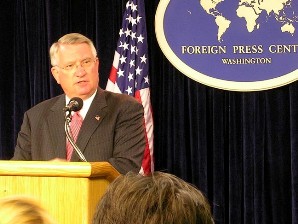Despite spending more than $1 billion between 1999 and 2004, the Office of National Drug Control Policy (ONDCP -- the drug czar's office) National Youth Anti-Drug Media Campaign has failed to demonstrate any measurable positive effects -- and it some cases, it may even have made youths more likely to use drugs, a new study has found.

The findings come from a congressionally-mandated study conducted by researchers at the University of Pennsylvania's Annenberg School of Communication. The researchers conducted four rounds of interviews conducted between 1999 and 2004, each involving about 5,000 to 8,000 youths between the ages of 9 and 18 years. The study will be published in the December edition of the American Journal of Public Health.
"The evidence does not support a claim that the campaign produced anti-marijuana effects," concluded the authors, led by Professor Robert Hornik. "There is little evidence for a contemporaneous association between exposure to anti-drug advertising and any of the outcomes... Non-users who reported more exposure to anti-drug messages were no more likely to express anti-drug beliefs than were youths who were less exposed," they wrote.
"Despite extensive funding, governmental agency support, the employment of professional advertising and public relations firms, and consultation with subject-matter experts, the evidence from the evaluation suggests that the National Youth Anti-Drug Media Campaign had no favorable effects on youths' behavior and that it may even have had an unintended and undesirable effect on drug cognitions and use," the report said.
The authors found that the anti-drug ads may have inadvertently suggested to youth that other kids were doing drugs. That could have had pushed more kids to try drugs, they suggested.
"Youths who saw the campaign ads took from them the message that their peers were using marijuana," the report found. "In turn, those who came to believe that their peers were using marijuana were more likely to initiate use themselves."
While the anti-drug message may have been muddled, the ads were seen. Overall, 94% of the youths interviewed reported seeing one or more ads a week, with an average frequency of two or three a week.
Still, teen marijuana use is down, declining by 40% between 1997, before the campaign began, and 2007, according to the annual Monitoring the Future surveys of 8th-, 10th-, and 12th-graders.
In an interview with ABC News last week, lead author Hornik said that the reported decline in marijuana use "could be due to lots of influences, not just the campaign." He said he had gone into the study expecting positive results, "but we couldn't find 'em."
This would appear to be a program ripe for the chopping block when Congress returns next year. After all, we are in for a time when we can't afford to be paying for unproven programs.
Comments
My copy of The Constitution must be broken(?)
Because I can`t seem to find ANY Constitutional authorization for *any* Federal drug laws.
Add new comment